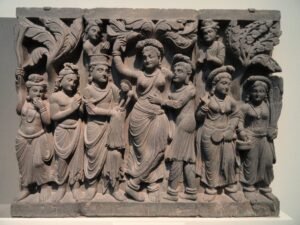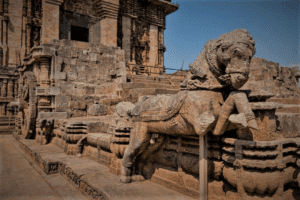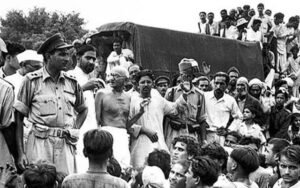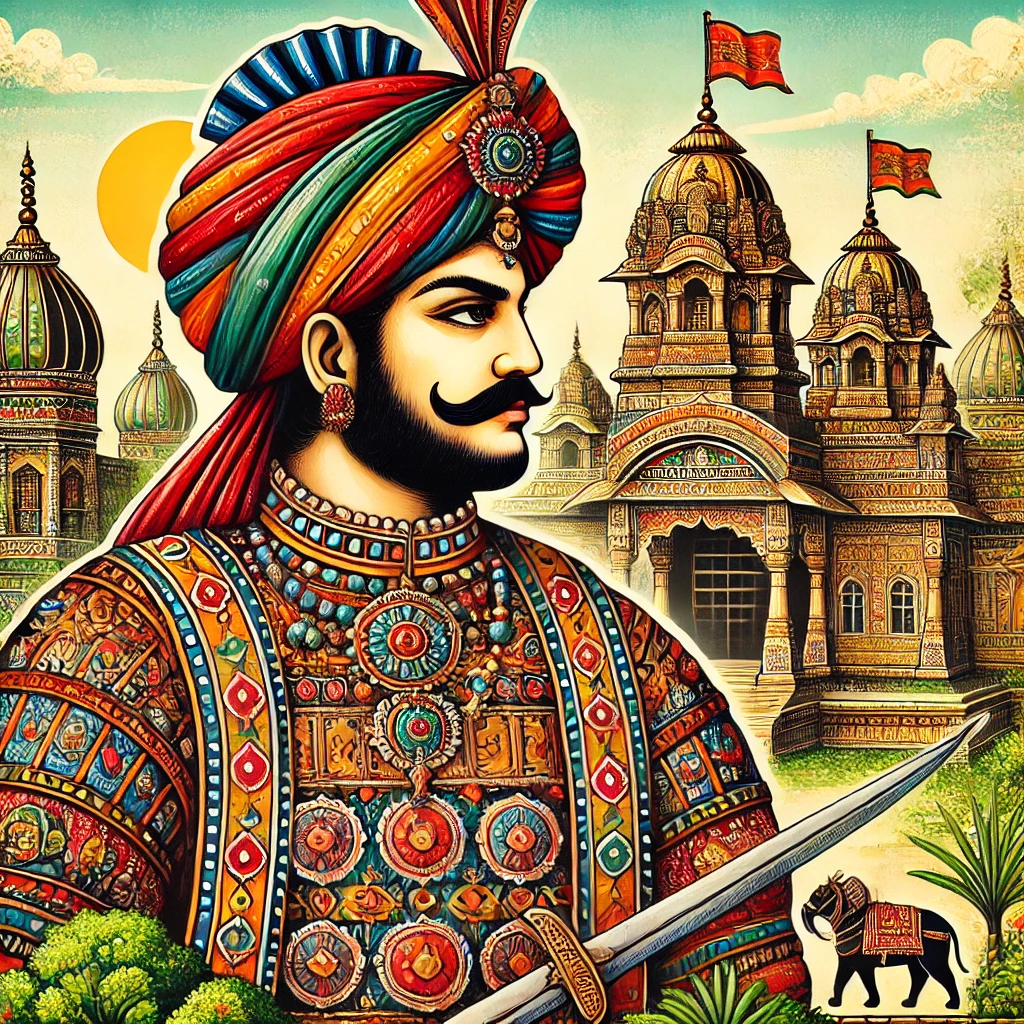
Raja Dahir: The Last Hindu King of Sindh
Raja Dahir was the last Hindu King of Sindh, an area that is now part of modern-day Pakistan. He ruled from 679 to 712 AD and remains a towering figure in the history of the Indian subcontinent. His reign represents a period of resilience and defiance in the face of overwhelming foreign aggression. Known for his valor and dedication to the preservation of Hindu culture, Raja Dahir’s leadership during a time of great turmoil left a lasting imprint on the history and culture of Sindh.
Sindh, often called the “Gateway of Islam” to the Indian subcontinent, was a region of strategic and cultural importance. Raja Dahir’s rule was marked by his efforts to protect his kingdom from external threats while fostering a thriving cultural and religious environment. The decline of the Hindu kingdom of Sindh, following the Arab conquest, led to profound changes, including the persecution of Hindus and the systematic erosion of their cultural identity—a legacy that continues to affect the Hindu community in Sindh to this day.
Early Life and Background
Raja Dahir was born in 663 CE into the Brahman dynasty of Sindh, a family deeply rooted in Hindu traditions and governance. His father, Chach of Aror, who ruled from 631 to 671 CE, was a Brahmin who ascended to the throne after marrying the widowed Queen Suhandi. This event established the Chach dynasty, which would rule Sindh for nearly a century.

The political environment during Dahir’s youth was one of consolidation and defense. Chach’s reign had been marked by efforts to stabilize the kingdom and fortify its borders, particularly against the encroaching forces of neighboring states. Growing up, Dahir was immersed in the arts of governance, military strategy, and the responsibilities of kingship. His early years were spent learning the complexities of ruling a diverse and strategically vital region.
Rise to Power
Raja Dahir ascended to the throne in 679 CE after the death of his elder brother, Chandar, who had ruled Sindh briefly after their father. Dahir’s ascension was not without challenges. He faced immediate threats from both internal factions and external forces. One of his first acts as king was to secure his rule by suppressing local rebellions and unifying the kingdom under his leadership.
Under Raja Dahir’s reign, Sindh saw a period of stability and cultural prosperity. He was committed to the preservation of Hinduism in the region and worked to promote religious harmony among his diverse subjects, including Hindus, Buddhists, Jains, and other religious communities. Raja Dahir’s administration was known for its fairness and dedication to the welfare of his people. He supported the construction of temples and promoted the arts, fostering an environment where culture and religion could flourish.
Political and Cultural Landscape of Sindh
Sindh during Raja Dahir’s reign was a beacon of Hindu culture and religious tolerance. The region was home to numerous temples, educational institutions, and centers of learning. These institutions played a crucial role in preserving and disseminating Hindu religious texts, philosophical discourses, and scientific knowledge.
One of the key achievements under Raja Dahir’s rule was the promotion of trade and commerce. Sindh, with its strategic location along the Indus River, was a major hub for trade between the Indian subcontinent, the Middle East, and Central Asia. The prosperity of Sindh during Dahir’s reign was reflected in the flourishing cities of Aror, Brahmanabad, and Debal, which were centers of commerce, culture, and intellectual activity.
Raja Dahir was also known for his efforts to strengthen the kingdom’s defenses. He fortified key cities and built strategic outposts along the borders to protect Sindh from invasions. His reign saw the construction of several forts and the enhancement of the kingdom’s military capabilities, ensuring that Sindh could resist external threats.
Key Events and Achievements Under Raja Dahir’s Rule
- 670s CE: Upon ascending the throne, Raja Dahir focused on consolidating his power by quelling internal dissent and securing alliances with local chieftains. His early reign was marked by efforts to unify the diverse population of Sindh, promoting religious tolerance and social harmony.
- 678-685 CE: Raja Dahir oversaw the construction and renovation of several Hindu temples, including those dedicated to Shiva and Vishnu, in key cities like Aror and Brahmanabad. These temples became centers of religious and cultural activity, attracting pilgrims and scholars from across the region.
- 680s CE: Raja Dahir strengthened Sindh’s trade relations with the Middle East and Central Asia. He established trade agreements that brought prosperity to the region, making Sindh one of the wealthiest and most culturally vibrant regions in the Indian subcontinent.
- 687 CE: Raja Dahir successfully defended Sindh against an invasion by Al-Hajjaj ibn Yusuf, the Umayyad governor of Iraq. Dahir’s forces repelled the initial Arab incursion, demonstrating his military prowess and commitment to protecting his kingdom from external threats.
- 691 CE: Raja Dahir initiated the construction of new forts along the Indus River to fortify the kingdom’s defenses. These forts played a crucial role in delaying the Arab advance during the subsequent invasions.
- 694 CE: Dahir organized a grand religious and cultural festival in Aror, celebrating the region’s Hindu heritage. The festival attracted participants from across the Indian subcontinent and showcased Sindh’s cultural and religious diversity.
- 708 CE: The incident involving the capture of a ship carrying Muslim women and children by pirates off the coast of Sindh became a turning point in Raja Dahir’s reign. Despite his efforts to negotiate a peaceful resolution, the event was used by the Umayyad Caliphate as a pretext for launching a full-scale invasion of Sindh.
The Arab Invasion: Context and Causes
The Arab invasion of Sindh was part of the broader expansionist ambitions of the Umayyad Caliphate, which sought to extend its control over the wealthy and strategically important regions of the Indian subcontinent. Sindh’s location along major trade routes and its economic prosperity made it a prime target for conquest.
The invasion was precipitated by the incident involving pirates who had taken refuge in Sindh and captured a ship carrying Muslim women and children. The Umayyad Caliphate, under the leadership of Al-Hajjaj ibn Yusuf, demanded their release. Raja Dahir, while denying any involvement in the incident, refused to extradite the pirates, believing it was a matter of Sindh’s sovereignty. This provided the Umayyad Caliphate with the justification to launch a military campaign against Sindh.
In 711 CE, Muhammad bin Qasim, a young and ambitious general, was appointed by Al-Hajjaj to lead the invasion. The campaign was part of a broader strategy to expand Islamic rule into the Indian subcontinent, with Sindh serving as the gateway for future conquests.
The Battle of Debal and Fall of Sindh
The Arab invasion began with the siege of Debal, a major port city in Sindh. Raja Dahir, aware of the threat posed by the Umayyad forces, gathered his troops and prepared to defend his kingdom. The Battle of Debal, fought in early 711 CE, was marked by intense fighting, with Raja Dahir personally leading his forces in the defense of the city.
Despite their valiant efforts, Dahir’s forces were overwhelmed by the superior numbers and advanced military tactics of the Umayyad army. The Arabs used powerful siege weapons, including catapults and battering rams, to breach the city’s defenses. After a fierce battle, Debal fell to the invaders, marking the beginning of the end for Hindu rule in Sindh.
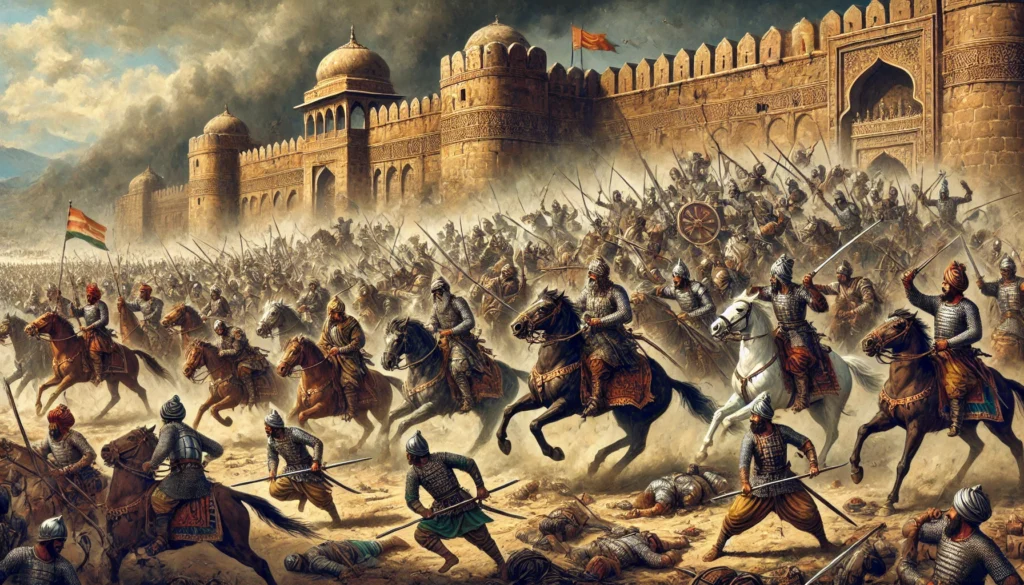
Following the fall of Debal, Raja Dahir retreated to the fortified city of Aror, where he made his last stand. The Battle of Aror, fought later in 711 CE, was the final confrontation between Raja Dahir and the Umayyad forces under Muhammad ibn al-Qasim. Despite being outnumbered and facing a formidable enemy, Dahir fought with unmatched valor, refusing to surrender his kingdom to foreign invaders. In the end, Raja Dahir was killed in battle, and with his death, the last Hindu kingdom of Sindh fell to the Umayyad Caliphate.
The Decline of Hindu Culture in Sindh
The fall of Sindh to the Umayyad Caliphate marked a turning point in the region’s history. The Arab conquest led to the systematic persecution of Hindus, who were subjected to harsh policies aimed at eradicating their religious and cultural practices. Hindu temples were destroyed or converted into mosques, and many Hindus were forced to convert to Islam under threat of violence or heavy taxation. Those who resisted faced severe penalties, including death or enslavement.
The decline of Hindu culture in Sindh was swift and profound. The once-thriving centers of Hindu learning and culture were dismantled, and the region’s rich Hindu heritage was systematically erased. The Arab rulers imposed Islamic law and sought to suppress Hindu religious practices, leading to the gradual erosion of Hinduism in the region.
Despite these challenges, many Hindus in Sindh continued to practice their religion in secret, preserving their traditions and passing them down through generations. This defiance in the face of persecution is a testament to the resilience of Sindh’s Hindu community, which has struggled to maintain its cultural identity despite centuries of adversity.
Present-Day Conditions and the Ongoing Struggle
Today, the legacy of Raja Dahir and the decline of Hindu culture in Sindh continue to shape the lives of the Hindu community in the region. Although Hindus constitute a minority in present-day Pakistan, they continue to face discrimination, violence, and persecution. Reports of forced conversions, abductions, and attacks on Hindu temples are not uncommon, highlighting the ongoing challenges faced by the community.
The Hindu population in Sindh has dwindled over the centuries, but those who remain have shown remarkable resilience in preserving their cultural and religious identity. Despite the pressures to assimilate, Sindhi Hindus have maintained their traditions, celebrating festivals, conducting religious ceremonies, and passing on their cultural heritage to future generations.

Hindu temple in Asha Pura, Pakistan
Efforts to preserve Hindu culture in Sindh have also been supported by the global Sindhi diaspora, which has worked to raise awareness of the challenges faced by Hindus in Pakistan and to provide support for cultural preservation initiatives. The story of Raja Dahir and the Hindu kingdom of Sindh serves as a powerful reminder of the importance of cultural resilience in the face of adversity.
Bibliography
- Avari, Burjor. India: The Ancient Past: A History of the Indian Subcontinent from c. 7000 BCE to CE 1200. Routledge, 2007.
- Quraishi, Ishtiaq Husain. The Muslim Community of the Indo-Pakistan Subcontinent (610-1947): A Brief Historical Analysis. K. Paul, Trench, Trubner & Co., 1951.
- Al-Baladhuri, Ahmad ibn Yahya. Futuh al-Buldan (The Conquests of the Lands). Translated by Phillip Hitti, Columbia University Press, 1916.
- Thapar, Romila. Early India: From the Origins to AD 1300. University of California Press, 2002.
- Asif, Manan Ahmed. A Book of Conquest: The Chachnama and Muslim Origins in South Asia. Harvard University Press, 2016.
- Elliot, Henry M., and John Dowson. The History of India as Told by Its Own Historians: The Muhammadan Period. Vol. 1. Trübner & Co., 1867.
- Wink, André. Al-Hind: The Making of the Indo-Islamic World. Vol. 1. Brill, 1991.
- MacLean, Derryl N. Religion and Society in Arab Sindh. Brill, 1989.
- https://indianexpress.com/article/pakistan/in-pakistans-sindh-province-hindu-culture-fights-the-odds-8255083/


